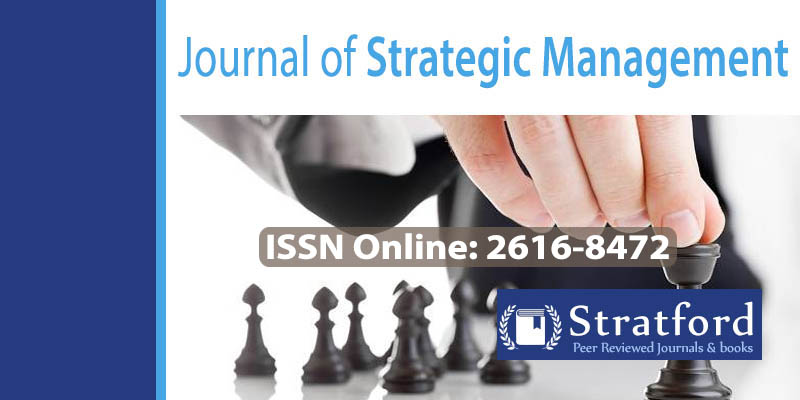Strategic Planning and Crisis Management in Textile Sector in Turkey
DOI:
https://doi.org/10.53819/81018102t4023Keywords:
Strategic Planning, Crisis Management, Textile Sector, TurkeyAbstract
Textile industries in Turkey are confronting changing difficulties at various times in this new millennium. Consequently, the world is becoming smaller in operational extent due to progress in information and communications technologies and other modern advances. The fractious cultural movements that induce successive crisis are confronted by organizations that risk their property, and therefore their on-going prospects. These have lately presented themselves in a variety of failures that range from financial failure, epidemics, and other natural calamities; violent actions among staffs and from terrorist factions as well. The private sector is confronting change as varied organizations experienced transitions, as a result of strong competition and compelling technological advances that arise during periods of socio-economic and political progress. Firms do not manage these factors by themselves but will respond to changes if they are required to strategically devise schemes. Planning for crises and responding appropriately to them, will make the firm improves its abilities to survive and thrive. Crisis management focuses on coping with threats, while strategic planning focuses on revealing opportunities. The use of strategic planning in the time of crisis will significantly benefit the firm by having advantages to operate and compete and also to have resilience in dealing with uncertainties. Therefore, to be resilient, firms will need to use intensively strategic planning in turbulent and changing situations in order to survive and thrive. It is the responsibility of managers and leaders in firms to consider all these types as possibilities for crises and have strategic and tactical plans, as a result crises could be rapidly resolved or prevented from happening. Strategic planning is critical to make sure that the textile sector is prepared to meet future difficulties. Modern strategy-oriented planning comprises a lengthy system for realizing a vision or managing future environmental conditions. The processes are neither fully prescriptive nor fully clear. Given this assumption, we typically characterize strategy-oriented planning processes in terms of structured activities that continually cover objectives and mission, survey the competitive environment, analyses strategic options, and coordinate implementing activities throughout an entire organization.
Keywords: Strategic Planning, Crisis Management, Textile Sector, Turkey
References
Agnihotri, A., & Bhattacharya, S. (2021). Didi Chuxing: Managing the Customer Safety Crisis. SAGE Publications: SAGE Business Cases Originals.
Athukorala, P. C., & Ekanayake, R. (2018). Repositioning in the global apparel value chain in the post‐MFA era: Strategic issues and evidence from Sri Lanka. Development Policy Review, 36, O247-O269.
Cook, C. N., & Kozar, J. M. (2017). The Competitive Advantages of Sourcing Agents in Global Apparel Supply Chains: An Exploratory Study. In The Customer is NOT Always Right? Marketing Orientations in a Dynamic Business World (pp. 86-95). Springer, Cham.
Erdil, A., & Taçgın, E. (2018). Potential risks and their analysis of the apparel & textile industry in Turkey: A quality-oriented sustainability approach. Fibres & Textiles in Eastern Europe.
Karasan, A., & Erdogan, M. (2021). Creating proactive behavior for the risk assessment by considering expert evaluation: a case of textile manufacturing plant. Complex & Intelligent Systems, 7(2), 941-959.
Majumdar, A., Sinha, S. K., & Govindan, K. (2021). Prioritizing risk mitigation strategies for environmentally sustainable clothing supply chains: Insights from selected organizational theories. Sustainable production and consumption, 28, 543-555.
McMaster, M., Nettleton, C., Tom, C., Xu, B., Cao, C., & Qiao, P. (2020). Risk management: Rethinking fashion supply chain management for multinational corporations in light of the COVID-19 outbreak. Journal of Risk and Financial Management, 13(8), 173.
Morais, F., & Franco, M. (2018). The role of cooperative alliances in internationalization strategy: Qualitative study of Portuguese SMEs in the textile sector. Journal of Strategy and Management.
Naiwen, L., Wenju, Z., Mohsin, M., Rehman, M. Z. U., Naseem, S., & Afzal, A. (2021). The role of financial literacy and risk tolerance: an analysis of gender differences in the textile sector of Pakistan. Industrial Textile, 72(3), 300-308.
Özdemir, M. M. (2020). Intersectional Vulnerability and Resilience: Syrian Male Refugee Textile Workers in Northwestern Turkey.
Ropianto, M., Rukun, K., Hayadi, B. H., Utami, F. H., & Candra, O. (2017). Optimization of Strategic Planning Organization in the Framework of Achievement Objectives of Education. Advances in Social Science, Education and Humanities Research (ASSEHR), 149(2), 149-151.
Shukla, A., Tiwari, M., & Bahukhandi, K. (2021). Hse Issues in Textile Industry.
Steven, R. J. (2020). Legal Risk in the Securities Settlement System. In Current Developments in Monetary and Financial Law, Vol. 1. International Monetary Fund.
Teixeira, G. F. G., & Junior, O. C. (2019). How to make strategic planning for corporate sustainability? Journal of Cleaner Production, 230, 1421-1431.
Teixeira, G., & Canciglieri, O. (2018). Application of strategy planning method to integrated development sustainable product process (PEPDIPS). In Advances in Cleaner Production, 7th International Workshop, Barranquilla (pp. 28-38).
Vallaster, C. (2017). Managing a company crisis through strategic corporate social responsibility: A practice‐based analysis. Corporate Social Responsibility and Environmental Management, 24(6), 509-523.
Warasthe, R., & Brandenburg, M. (2018). Sourcing organic cotton from African countries potentials and risks for the apparel industry supply chain. IFAC-PapersOnLine, 51(30), 297-301.


